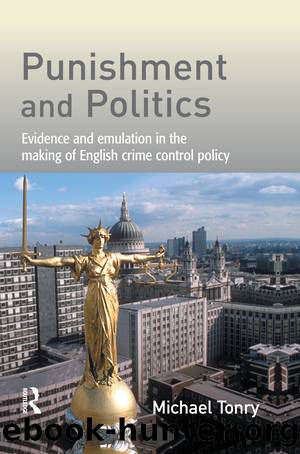Punishment and Politics by Michael Tonry

Author:Michael Tonry [Tonry, Michael]
Language: eng
Format: epub
Tags: Social Science, Criminology
ISBN: 9781135998189
Google: Uh5-KdYyLxcC
Publisher: Routledge
Published: 2012-12-06T04:44:05+00:00
The proposal raises three important sets of policy issues: costs, international comparisons and crime-prevention effects. First consider costs. Confining one prisoner for one year in an English prison costs £36,000 (Home Office 2003). As I write, Her Majestyâs prisons hold about 75,000 people. Reducing the population to 50,000 would save £900 million per year. This might be thought of as a ârelease dividend.â Of course, it couldnât be done all at once, so the full annual savings would not be realized until the change was fully phased in. Nearly nine hundred million per year is not a small sum to be freed up for other uses, some within the prison and probation systems.
The resulting imprisonment rate of 85â95 per 100,000 population would then be ordinary by European standards â a bit higher than those in Scandinavia and about the same as those in France, Germany and Italy, the other most populated countries in the EU. English crime rates and recent crime trends fall within normal patterns for large countries, so thereâs no obvious reason why English imprisonment rates should be the highest of the large European countries.
Now consider crime prevention. Though this may seem counterintuitive, reducing the prison population by a third should bring crime rates down. There are several reasons for this. First, recidivism studies comparing re-offending by people released from prisons or community penalties generally conclude that ex-prisoners do worse and have higher re-offending rates. They certainly do not do better. The Halliday report conservatively concluded, â[T]here is currently no discernible difference between reconviction rates for custody and for community penaltiesâ (Home Office 2001b: 126). Since the eighteenth-century times of John Howard, critics have characterized prisons as schools for crime in which offenders become more deeply socialized into criminal values and from which they are released stigmatized as âex-consâ. This is why several countries, including Germany, have nearly eliminated the use of prison sentences of six months or less (Weigend 2001). They are seen as too short to allow rehabilitative programmes to be effective, but long enough for prisoners to lose their jobs, their homes and their families. So reducing the prison population will not result in more crimes by people whoâve completed their sentences, and will lessen prisonsâ criminogenic effects.
Second, deterrence. Although some people, including many judges, believe that harsher penalties have greater deterrent effects than milder ones, there is no evidence that this is true. To the contrary, every serious review of research in the past quarter century on the deterrent effects of punishment has concluded that there is no evidence to support the belief that incremental differences in punishment have measurable deterrent effects (von Hirsch et al. 1999; Blumstein et al. 1978; Reiss and Roth 1993; Cook 1980; Nagin 1998; Doob and Webster 2003). Here is what Halliday said, â[T]here seems to be no link between marginal changes in punishment levels and changes in crime rates ⦠It is the prospect of getting caught that has deterrence value, rather than alterations to the âgoing rateâ for severity of sentencesâ (Home Office 2001b: 8).
Download
This site does not store any files on its server. We only index and link to content provided by other sites. Please contact the content providers to delete copyright contents if any and email us, we'll remove relevant links or contents immediately.
Chaco's Northern Prodigies : Salmon, Aztec, and the Ascendancy of the Middle San Juan Region after AD 1100 by Paul F. Reed(355)
Law Enforcement Interpersonal Communication and Conflict Management by Brian Douglas Fitch(349)
Digital International Relations by Unknown(347)
Critical Perspectives on Human Security : Rethinking Emancipation and Power in International Relations by David Chandler; Nik Hynek(330)
Skilled interpersonal communication: Research, theory and practice, Fifth edition by Owen Hargie(328)
The Enduring Color Line in U.S. Athletics by Krystal Beamon Chris M. Messer(326)
Evidence-Based Policy Making in Labor Economics by Hamermesh Daniel S.;Nottmeyer Olga K.;Nottmeyer Olga;King Sarah;King Sarah;King Sarah;(299)
EPSO CAST Political affairs EU policies: How to succeed in the selection procedure by Franco Reverte José María(293)
Writing Public Policy - A Practical Guide to Communicating in the Policy Making Process by Catherine F. Smith(272)
Criminological Theory in Context by John Martyn Chamberlain(271)
Tibeton Yoga Its Secret Doc by Evans-Wentz(268)
Threshold Concepts in Women's and Gender Studies by Christie Launius Holly Hassel(266)
Rothschild and Early Jewish Colonization in Palestine (Geographical Perspectives on the Human Past) by Ran Aaronsohn(266)
Positive Psychology and Spirituality in Counselling and Psychotherapy (Conflict, Ethics, and Spirituality, 12) by unknow(261)
Social Problems, Social Issues, Social Science by James Wright(260)
Play in child development and psychotherapy: toward empirically supported practice by Sandra W. Russ(254)
Cognitive Development in Infancy and Childhood (Elements in Child Development) by Mary Gauvain(253)
Latin American Politics and Society by Gerardo L. Munck & Juan Pablo Luna(224)
What Makes a Social Crisis?: The Societalization of Social Problems by Jeffrey C. Alexander(220)
